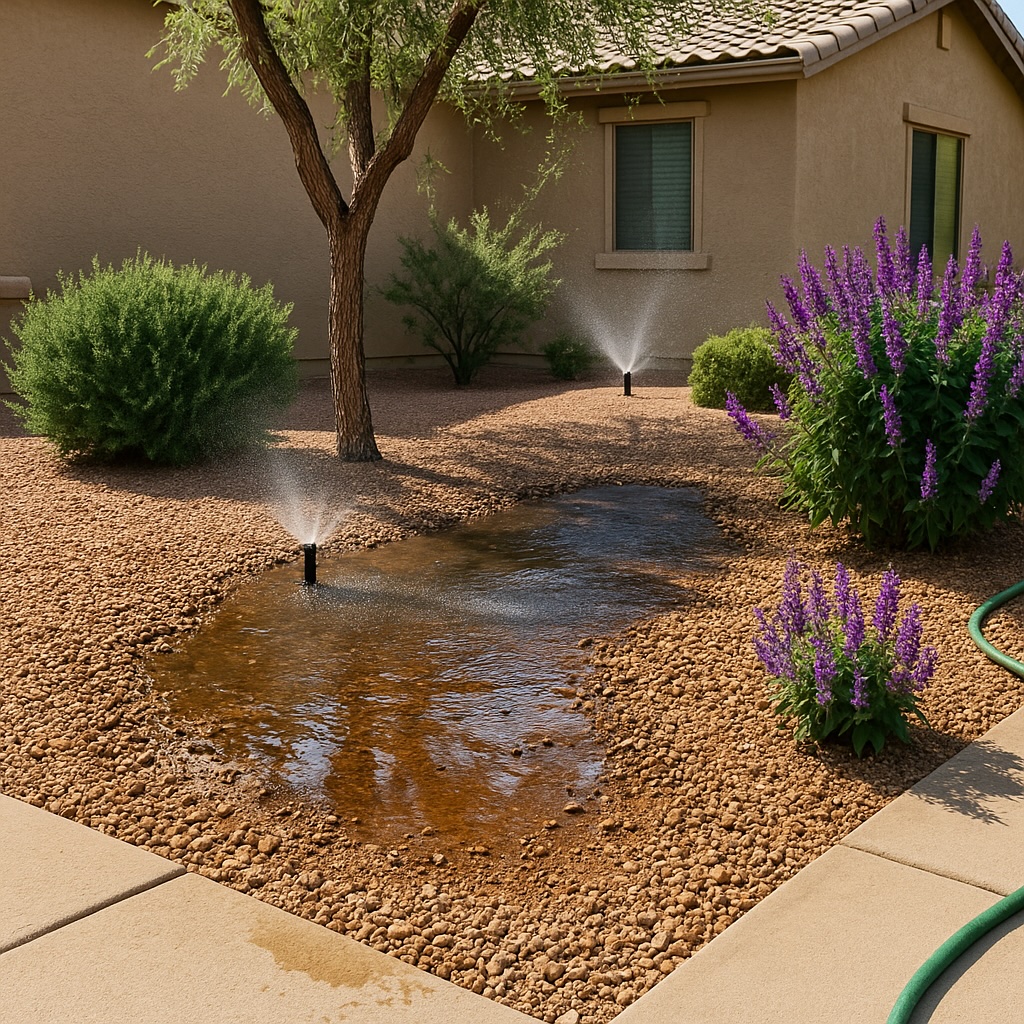In Gilbert, Arizona, efficient water use is more than a good habit—it’s a necessity. With our hot, dry climate and limited rainfall, overwatering is one of the most common (and costly) landscaping mistakes. It wastes a precious resource, weakens plants, and encourages disease. Fortunately, preventing overwatering is easy once you understand the signs and implement a few smart practices tailored for desert landscapes.
Why Overwatering is a Big Problem in Desert Yards
It’s easy to assume that hot temperatures call for constant watering, but desert-adapted plants and soils are built to retain moisture. Overwatering drowns roots, leaches nutrients, and can lead to fungal problems. What’s worse—it encourages shallow root systems, making plants more vulnerable to heat and drought stress.

Common Signs You’re Overwatering
Here are red flags that you may be giving your yard more water than it needs:
- Standing water or puddles on gravel or near plant roots
- Yellowing or wilting leaves even when soil is wet
- Fungus or mold growth on soil or mulch
- Mushy roots or a sour smell from garden beds
- Frequent runoff from sprinklers or drip lines
If your plants seem stressed but the soil is consistently wet, too much water is likely the culprit.
Best Practices for Smart Irrigation in Gilbert
To prevent overwatering and make the most of every drop, follow these local-friendly irrigation tips:
- Water in the early morning: Between 4–7 a.m. is ideal to reduce evaporation and fungal risks.
- Use drip irrigation: Targeted watering reduces waste and prevents over-saturating surrounding areas.
- Water deeply but less often: Promote deeper root growth and drought resilience.
- Adjust by season: Plants need far less water in spring and fall than in peak summer.
- Avoid midday watering: It leads to evaporation and scalding when droplets magnify sun rays.
If you’re not sure how much to water, check the soil before you irrigate. Stick your finger or a soil moisture meter a few inches into the ground—only water if it feels dry.
Landscape Design That Reduces Overwatering Risk
Your yard’s layout can help or hinder efficient watering. These strategies can help your Gilbert landscape thrive with less water:
- Choose native or desert-adapted plants: Like lantana, salvia, desert spoon, and red yucca.
- Use mulch: Gravel or wood mulch reduces evaporation and keeps roots cool.
- Group plants by water needs: So high-use plants don’t affect xeriscape areas.
- Improve grading: Ensure water flows away from your foundation and doesn’t pool.
Homes in Gilbert can also benefit from water-wise landscape conversions, which may be eligible for local rebates. Check with the Town of Gilbert Water Conservation Office for current programs and resources.
Seasonal Watering Adjustments for the Gilbert Climate
Desert irrigation isn’t a “set it and forget it” task. Here’s a seasonal guide to help you adapt your watering routine:
- Spring: Start slowly as nights are still cool. Plants are coming out of dormancy and don’t need much.
- Summer: Increase frequency but shorten durations to prevent water loss.
- Fall: Scale back gradually as temperatures drop.
- Winter: Most native plants need little to no irrigation unless it’s extremely dry.
Tools That Help You Stay in Control
Modern tools make it easier than ever to prevent overwatering in Gilbert:
- Smart irrigation controllers: Adjust watering based on weather, soil, and plant needs.
- Soil moisture sensors: Tell you exactly when and how much to water.
- Rain shutoff switches: Prevent unnecessary watering after storms.
Installing even one of these tools can dramatically reduce water use and keep your yard healthier.
Final Thoughts
Learning how to prevent overwatering in Gilbert is a key step toward building a sustainable, low-maintenance yard. By understanding your plants, upgrading your irrigation habits, and paying attention to seasonal needs, you’ll protect your landscape, save on your water bill, and contribute to a healthier desert ecosystem.
